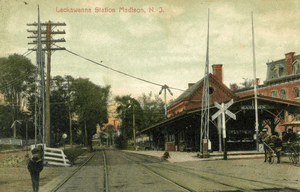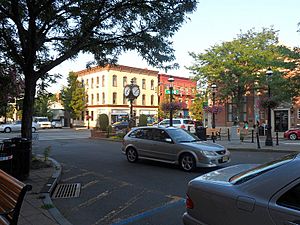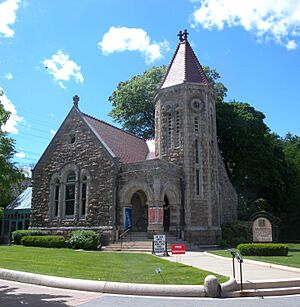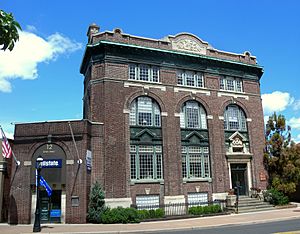Madison, New Jersey facts for kids
Quick facts for kids
Madison, New Jersey
|
|||
|---|---|---|---|
|
Borough
|
|||
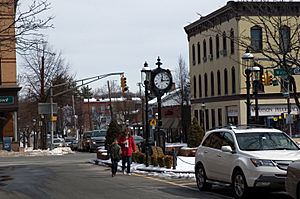
Main Street in Downtown Madison
|
|||
|
|||
| Nickname(s):
The Rose City
|
|||

Location of Madison in Morris County highlighted in red (right). Inset map: Location of Morris County in New Jersey highlighted in orange (left).
|
|||

Census Bureau map of Madison, New Jersey
|
|||
| Country | |||
| State | |||
| County | |||
| Incorporated | December 27, 1889 | ||
| Named for | President James Madison | ||
| Government | |||
| • Type | Borough | ||
| • Body | Borough Council | ||
| Area | |||
| • Total | 4.33 sq mi (11.20 km2) | ||
| • Land | 4.31 sq mi (11.17 km2) | ||
| • Water | 0.01 sq mi (0.03 km2) 0.30% | ||
| Area rank | 288th of 565 in state 24th of 39 in county |
||
| Elevation | 266 ft (81 m) | ||
| Population
(2020)
|
|||
| • Total | 16,937 | ||
| • Estimate
(2023)
|
16,432 | ||
| • Rank | 158th of 565 in state 13th of 39 in county |
||
| • Density | 3,926.6/sq mi (1,516.1/km2) | ||
| • Density rank | 165th of 565 in state 6th of 39 in county |
||
| Time zone | UTC−05:00 (Eastern (EST)) | ||
| • Summer (DST) | UTC−04:00 (Eastern (EDT)) | ||
| ZIP Code |
07940
|
||
| Area code(s) | 973 | ||
| FIPS code | 3402742510 | ||
| GNIS feature ID | 0885287 | ||
Madison is a borough in Morris County, in the U.S. state of New Jersey. As of the 2020 United States census, the borough's population was 16,937, an increase of 1,092 (+6.9%) from the 2010 census count of 15,845, which in turn reflected a drop in population of 685 (−4.1%) from the 16,530 counted in the 2000 census.
Madison is noted for its historic railroad station. The station is located on the Morris & Essex Lines, which was one of the nation's first commuter railroads. Many wealthy residents of Manhattan relocated to Madison and its surrounding communities since the rail line offered direct transport to New York City. Madison is known as "The Rose City" and was named in honor of President James Madison.
Madison was ranked 33rd in Money magazine's ranking of the "Best Places to Live" in 2011, the third-highest ranked location in New Jersey and second-highest in Morris County behind Montville. New Jersey Monthly ranked Madison first in its 2019 rankings of the "Best Places to Live" in New Jersey.
Madison is a college town that is the home of both Drew University and Fairleigh Dickinson University; Saint Elizabeth University is located in neighboring Convent Station, New Jersey. Madison is also home to the Shakespeare Theatre of New Jersey, one of the largest professional Shakespeare companies in North America.
Contents
History
Pre-settlement
Native Americans occupied present-day Madison and most of New Jersey for several thousand years, following the retreat of the Wisconsin Glacier. Lenape settlements in present-day Madison were agriculturally-based following matrilineal lines. The protected lands nearby, Jockey Hollow, are what is remaining of the settlement. Occupation changed with the seasons, the variable nature of the climate, and to preserve the fertility of the rich soil. Their fishing and hunting territories were wide-ranging and similarly divided among the three clans of the matrilineal culture in this Eastern Woodland environment. Trade with these native peoples for food and furs was conducted by the Dutch during the period of colonization of New Netherland. Although the European principle of land ownership was not recognized by the Lenape, Dutch West India Company policy required their colonists to purchase land that they settled, but typically, trading relationships were established in this area, rather than Dutch settlements.
18th century
During the British colonial period of the 17th and 18th centuries, the earliest settlers arriving in Madison were of European descent in what was then the colonial-era Province of New Jersey. Traditional native trails and pathways were followed as settlement began. Pressures upon the Lenape constantly drove them westward.
In or around 1715, Bottle Hill, a village, was established at the crossing of Ridgedale Avenue and Kings Road. Village governance principles followed the British model. The Luke Miller house at 105 Ridgedale Avenue is thought to be the oldest remaining home, having been built around 1730. During British colonial rule, Kings Road was a toll road that assessed fees levied by the government appointed by the English king. Farther south was the Shunpike, a road with a parallel path that was used by colonists to avoid the fees.
In 1739, Morris County, New Jersey was founded and was divided into three townships. The portion of the village north of Kings Road was put under the governance of Hanover Township and the portion to the south, under the governance of Morris Township. A meeting house for the Presbyterian Church of South Hanover, as Madison was then called, was started in 1747 where the Presbyterian Cemetery still exists between Kings Road and Madison Avenue. With the Treaty of Easton in 1758, the Lenape were required to vacate their lands in colonial New Jersey and to move westward. Their leaders allied with the colonists during the American Revolutionary War in hopes of regaining former lands, but those hopes were never realized.
Following the American Revolution, changes to governing the former colonies occurred gradually as the new nation organized. The state of New Jersey formed its government and debated best policies.
19th century
During a reorganization of Morris County in 1806, Chatham Township was established and included all of present-day Chatham Township and the three pre-Revolutionary War villages of Chatham, Florham Park, and Madison, which were still governed by Chatham Township, and ended the governmental division of Bottle Hill.
In 1834, the name of the settlement was changed to Madison. As a tribute to the name every year there is a fair that is called Bottle Hill Day.
In 1838, the Morris and Essex Railroad was founded, connecting Newark and Hoboken and providing transportation for farm produce grown in Madison. The railroad made possible the establishment of a flourishing rose growing industry, still commemorated in Madison's nickname, The Rose City. The rail service connected the commerce to the markets of Manhattan. Madison's growth accelerated after the Civil War and the Morris and Essex Lines became one of America's first commuter railroads, attracting well-to-do families from Manhattan (many of whom already owned large parcels land in the area for farming, hunting, and recreation) and contributing to the development of "Millionaire's Row", which stretched from downtown Madison to downtown Morristown. Greenhouses dotted the countryside. Talented horticulturalists were attracted to the area for employment at the many wealthy estates in the immediate area and to establish related businesses. One of the first grand houses to be built on "Millionaire's Row" was the Ross Estate. In 1893, Florence Adele Vanderbilt and her husband Hamilton McKown Twombly began to build the impressive Florham estate. Home to Fairleigh Dickinson University, Florham is a Gilded Age mansion and the 9th largest house in the United States.
On December 27, 1889, based on the results of a referendum passed on December 24, 1889, the village seceded from Chatham Township and adopted the newly created, borough government (when it first became available), to develop a local water supply system for its population of 3,250. Madison annexed additional portions of Chatham Township in 1891, and again each year from 1894 to 1898, which was followed by an exchange of certain lands in 1899 with Chatham Township.
Madison's historic railroad station was funded by the community, which passed an ordinance authorizing $159,000 for railroad improvement bonds. The result, with the cooperation of the D.L. & W.R.R. in the planning, was completed in 1916. The tracks were elevated through the downtown so that no established roadways were hindered by crossing delays. Mrs. D. Willis James financed much of the road grading caused by the elevation of the tracks. The station included baggage and cargo facilities readily accessible by wagon, as well as the stationmaster offices, a newsstand, and waiting facilities featuring extensive banks of high-backed wooden seating. Weeping mulberry trees were planted among the landscaping and in natural areas in the parking area.
The rose industry and the large estates in the area attracted working-class people of all kinds. As a result, Madison developed a diverse population very early, both in terms of socioeconomic status and ethnic background. The original settlers were of British stock; French settlers came after the American Revolution; African Americans have been members of the community from early in the nineteenth century; Irish came in the mid-nineteenth century; and then Germans and Italians arrived around the turn of the twentieth century. To this day there is a substantial population of Italian descent in Madison. Madison remains a diverse community, with recent newcomers arriving from Central America, South America, and Asia. Madison is a railroad suburb of New York City.
20th century
The Evergreen Cemetery was mentioned in Weird NJ for an incident in 1902, when after a downpour, bodies were found on the streets.
Geography
According to the U.S. Census Bureau, the borough had a total area of 4.33 square miles (11.20 km2), including 4.31 square miles (11.17 km2) of land and 0.01 square miles (0.03 km2) of water (0.30%). Madison is located about 25 miles (40 km) west of downtown Manhattan, and is a suburban town of New York City.
Madison borders the Morris County municipalities of Chatham Borough to the east, Chatham Township to the south, Harding Township and Morris Township to the west and Florham Park to the north.
Unincorporated communities, localities and place names located partially or completely within the borough include Brooklake Park, East Madison and North Park.
| Climate data for Madison, New Jersey | |||||||||||||
|---|---|---|---|---|---|---|---|---|---|---|---|---|---|
| Month | Jan | Feb | Mar | Apr | May | Jun | Jul | Aug | Sep | Oct | Nov | Dec | Year |
| Record high °F (°C) | 73 (23) |
76 (24) |
89 (32) |
96 (36) |
97 (36) |
102 (39) |
103 (39) |
104 (40) |
99 (37) |
93 (34) |
84 (29) |
76 (24) |
104 (40) |
| Mean daily maximum °F (°C) | 39 (4) |
42 (6) |
51 (11) |
62 (17) |
73 (23) |
82 (28) |
86 (30) |
85 (29) |
78 (26) |
66 (19) |
55 (13) |
44 (7) |
64 (18) |
| Mean daily minimum °F (°C) | 18 (−8) |
20 (−7) |
28 (−2) |
38 (3) |
47 (8) |
57 (14) |
63 (17) |
61 (16) |
53 (12) |
40 (4) |
32 (0) |
24 (−4) |
40 (4) |
| Record low °F (°C) | −25 (−32) |
−26 (−32) |
−6 (−21) |
12 (−11) |
25 (−4) |
31 (−1) |
41 (5) |
35 (2) |
26 (−3) |
13 (−11) |
−5 (−21) |
−16 (−27) |
−26 (−32) |
| Average precipitation inches (mm) | 3.54 (90) |
2.91 (74) |
4.20 (107) |
4.29 (109) |
4.38 (111) |
4.70 (119) |
4.73 (120) |
4.42 (112) |
4.89 (124) |
4.65 (118) |
4.06 (103) |
4.13 (105) |
50.9 (1,292) |
| Source: Weather Channel | |||||||||||||
Demographics
| Historical population | |||
|---|---|---|---|
| Census | Pop. | %± | |
| 1880 | 1,756 | — | |
| 1890 | 2,469 | 40.6% | |
| 1900 | 3,754 | 52.0% | |
| 1910 | 4,658 | 24.1% | |
| 1920 | 5,523 | 18.6% | |
| 1930 | 7,481 | 35.5% | |
| 1940 | 7,944 | 6.2% | |
| 1950 | 10,417 | 31.1% | |
| 1960 | 15,122 | 45.2% | |
| 1970 | 16,710 | 10.5% | |
| 1980 | 15,357 | −8.1% | |
| 1990 | 15,850 | 3.2% | |
| 2000 | 16,530 | 4.3% | |
| 2010 | 15,845 | −4.1% | |
| 2020 | 16,937 | 6.9% | |
| 2023 (est.) | 16,432 | 3.7% | |
| U.S. Decennial Census 1880–1890 1890–1920 1890–1910 1890–1930 1940–2000 2000 2010 2020 |
|||
2020 census
As of the 2020 United States census, there were 16,937 people, 5,745 households, and 3,931 families residing in the borough. The population density was 3,927.0 inhabitants per square mile (1,516.2/km2).
2010 census
The 2010 United States census counted 15,845 people, 5,485 households, and 3,675 families in the borough. The population density was 3,767.9 per square mile (1,454.8/km2). There were 5,775 housing units at an average density of 1,373.3 per square mile (530.2/km2). The racial makeup was 86.75% (13,746) White, 2.96% (469) Black or African American, 0.12% (19) Native American, 5.51% (873) Asian, 0.01% (2) Pacific Islander, 2.34% (371) from other races, and 2.30% (365) from two or more races. Hispanic or Latino of any race were 8.87% (1,406) of the population.
Of the 5,485 households, 34.5% had children under the age of 18; 56.0% were married couples living together; 8.7% had a female householder with no husband present and 33.0% were non-families. Of all households, 27.2% were made up of individuals and 11.4% had someone living alone who was 65 years of age or older. The average household size was 2.58 and the average family size was 3.19.
23.7% of the population were under the age of 18, 13.6% from 18 to 24, 23.7% from 25 to 44, 24.7% from 45 to 64, and 14.2% who were 65 years of age or older. The median age was 38.0 years. For every 100 females, the population had 89.9 males. For every 100 females ages 18 and older there were 85.3 males.
The Census Bureau's 2006–2010 American Community Survey showed that (in 2010 inflation-adjusted dollars) median household income was $106,070 (with a margin of error of +/− $8,499) and the median family income was $139,886 (+/− $18,117). Males had a median income of $100,289 (+/− $12,722) versus $64,684 (+/− $10,127) for females. The per capita income for the borough was $54,518 (+/− $4,561). About 1.1% of families and 4.3% of the population were below the poverty line, including 1.6% of those under age 18 and 2.7% of those age 65 or over.
Economy
Madison's downtown is supported by the Madison Downtown Development Commission and a downtown manager. Many historical buildings remain in the community. The Madison Civic Commercial Historic District, which includes much of "downtown" as well as the borough hall and the train station, is listed on the State Register of Historic Places. The borough hall was donated to the community by Geraldine R. Dodge and Marcellus Hartley Dodge Sr. as a memorial to their son who died in an automobile crash shortly after his graduation from Princeton University. Commercial vacancy rates are low. In recent years Madison has become noted for the number and quality of its restaurants.
Giralda Farms, a planned office development, occupies 175 acres (0.71 km2) of the former Geraldine R. Dodge estate in Madison The site includes the corporate headquarters of Quest Diagnostics. Covering 181 acres (73 ha), the site requires that all parking be underground and that 85% of the land be undeveloped.
Arts and culture
Madison holds an annual event, Bottle Hill Day, during which the community is able to celebrate with games, food, music, and a variety of activities for as many as 20,000 participants.
Madison is home to the Shakespeare Theatre of New Jersey, one of 25 professional theatres in the state. Serving 100,000 adults and children annually, it is New Jersey's only professional theatre company dedicated to Shakespeare's canon and other classic masterworks. The F.M. Kirby Shakespeare Theatre, the company's main stage, is a short walk from Madison's downtown shopping district.
Madison is also home to the Museum of Early Trades and Crafts, a New Jersey history museum located in the historic downtown district. The building is listed on both the state and national registers of historic buildings. The museum houses a collection of more than 8,000 artifacts and is host to thousands of visitors each year, mostly school students on field trips.
In October 2017, it was announced that a long-lost sculpture by Auguste Rodin had been found in the Hartley Dodge Memorial. A student from Drew University, who had been hired to archive the art in the building, discovered the bust of Napoleon and reached out to the Comité Auguste Rodin in Paris to have it authenticated. A public viewing was held for locals before the statue was loaned to the Philadelphia Museum of Art.
Education
Public schools
The Madison Public Schools serve students in pre-kindergarten through twelfth grade. As of the 2018–19 school year, the district, comprised of five schools, had an enrollment of 2,646 students and 219.5 classroom teachers (on an FTE basis), for a student–teacher ratio of 12.1:1. Schools in the district (with 2018–19 enrollment data from the National Center for Education Statistics) are Central Avenue School (499 students; in grades Pre-K–5), Kings Road School (310; K–5), Torey J. Sabatini School (316; K–5), Madison Junior School, (618; 6–8) and Madison High School (879; 9–12).
Students from Harding Township attend the district's high school as part of a sending/receiving relationship with the Harding Township School District.
Private schools
St. Vincent Martyr School (SVMS) is a Catholic parochial school, established in 1848, that serves students in grades Pre-K–3 through eight, operated under the auspices of the Saint Vincent Parish and the Roman Catholic Diocese of Paterson. SVMS is a recipient of the No Child Left Behind National Blue Ribbon School Award of Excellence for 2005–2006. Rainbow Montessori School, founded in 1981, is a Montessori school teaching children in Pre-K and kindergarten.
Higher education
Seton Hall College (now Seton Hall University) was established in Madison in 1856 and relocated to its location in South Orange, New Jersey, in the late 19th century.
Drew University was founded in 1867 and continues to operate in Madison, on a wooded campus near downtown that was previously a private residence.
Fairleigh Dickinson University's Florham Campus is located in Madison on the former Twombly estate.
Landmark Conference, an NCAA Division III conference, is based in Madison.
Saint Elizabeth University is located just outside Madison, in Convent Station in Morris Township.
Transportation
Roads and highways
As of May 2010[update], the borough had a total of 54.73 miles (88.08 km) of roadways, of which 46.38 miles (74.64 km) were maintained by the municipality, 4.76 miles (7.66 km) by Morris County and 3.59 miles (5.78 km) by the New Jersey Department of Transportation.
The main thoroughfare is Route 124 which connects with Morris Township in the northwest and Chatham Borough to the southeast.
Route 24 is the only limited access road to pass through the borough, doing so briefly for 0.47 miles (0.76 km), but the closest exit is in neighboring Florham Park.
Public transportation
NJ Transit provides trains service at the Madison station. Commuter service is available on the Morristown Line, with trains heading to Hoboken Terminal, and to Penn Station in Midtown Manhattan via the Kearny Connection.
NJ Transit provides local bus service on the 873 route, replacing service that had been offered on the MCM3 until subsidies to the local providers were eliminated in 2010 as part of budget cuts.
Madison also has a private commuter bus line run by Boxcar Transit that operates five days a week, running directly to and from Midtown Manhattan.
A low-cost campus/downtown shuttle bus operates along Madison Avenue and Main Street during afternoon and evening hours.
Sister cities
Madison has three sister cities:
 Issy-les-Moulineaux, France
Issy-les-Moulineaux, France Marigliano, Italy
Marigliano, Italy Madison, Connecticut, United States
Madison, Connecticut, United States
Points of interest
- Drew University
- Fairleigh Dickinson University
- Grace Episcopal Church
- Museum of Early Trades and Crafts
- The Shakespeare Theatre of New Jersey
- Thursday Morning Club
Film and television
- Episodes of the television series, The Sopranos, were filmed in Madison. A scene was filmed on the Drew University campus, while another scene was filmed at Rod's Steak House, just west of the borough limits in Convent Station.
- Portions of A Beautiful Mind were filmed at Fairleigh Dickinson University in Madison.
- The Madison train station played the role of Cranford, New Jersey, in the 2005 film, Guess Who starring Bernie Mac and Ashton Kutcher. The train station, the Hartley-Dodge Memorial building, and the center of Madison serve as backdrops to this movie, and a panorama of the borough is shown during the final credits.
- Hartley Dodge Memorial (Borough Hall) appears in a scene of The World According to Garp starring Glenn Close and Robin Williams.
- Scenes from The Family Stone (2005) were shot downtown at the intersection of Main Street and Waverly Place and Drew University. Despite the fact that the fictional town is supposed to be in New England, one may see a train, clearly marked New Jersey Transit, crossing through Waverly Place in one of the scenes. Additionally, the bus station featured in the movie was shot on Drew University campus in Madison.
- Scenes from Woody Allen's Deconstructing Harry (1997) were filmed on the Drew University campus.
- The original 1968 green Ford Mustang GT driven by Steve McQueen in Bullitt disappeared until it was purchased by Madison resident Robert Kiernan in 1974 from an ad in Road & Track magazine.
Notable people
People who were born in, residents of, or otherwise closely associated with Madison include:
- Robert Adams (born 1937), photographer who has focused on the changing landscape of the American West
- Lincoln Brower (1931–2018), was an American entomologist and ecologist, best known for his research on monarch butterflies
- Andy Breckman (born 1955), creator and producer of television series Monk, former Saturday Night Live writer and radio personality
- Jonathan Edward Caldwell (born 1883), aeronautical engineer whose designs included an ornithopter, which would have flown by flapping its wings
- Robert L. Chapman (1920–2002), thesaurus editor
- Samuel S. Coursen (1926–1950), awarded the Medal of Honor for his actions during the Korean War
- Dick DeBiasse, automotive engineer and machinist (founder of AER Research, also located in Madison), is credited with having contributed to the success of the Lake Underwood team that established Porsche as a winning race car in the United States. He also did the motor work for Mark Donohue in the following decade.
- Geraldine Rockefeller Dodge (1882–1973), philanthropist and noted dog breeder and judge
- Marcellus Hartley Dodge Sr. (1881–1963), chairman of the board of Remington Arms
- Marcellus Hartley Dodge Jr. (1908–1930), heir to the Remington-Rockefeller fortune
- Alexander Duncan (1788–1853), Member of the United States House of Representatives from Ohio
- Jonathan Dwight (1858–1929), ornithologist
- Dean Faiello (born 1959), fake doctor convicted of operating without a license after the 2003 death of a patient
- Janeane Garofalo (born 1964), actor, comedian, author, and activist moved to Madison at age nine, where she remained until she graduated from high school
- Marcel Gleyre (1910–1996), gymnast who competed in the men's vault event at the 1932 Summer Olympics
- Nick Mangold (born 1984), former NFL pro-bowl center with the New York Jets
- William McGurn (born 1958), former speechwriter for George W. Bush
- Ted Mitchell (1905–1985), American football center who played in the NFL for the Orange/Newark Tornadoes
- Don Newcombe (1926–2019), former Major League Baseball right-handed starting pitcher who played for the Brooklyn/Los Angeles Dodgers, Cincinnati Reds and Cleveland Indians
- Neil O'Donnell (born 1966), former NFL quarterback
- Greg Olear (born 1972), novelist
- Horace W. Palmer (1878–1953), lawyer and politician who served in the New York State Assembly
- Edward Irenaeus Prime-Stevenson (1858–1942), author of Imre: A Memorandum, who wrote under the pseudonym Xavier Mayne
- Aubrey Eugene Robinson Jr. (1923–2000), Chief Federal Judge of the District Court of the District of Columbia, appointed by Lyndon B. Johnson in 1966
- Jay P. Rolison Jr. (1929–2007), lawyer and politician from New York who served in the New York Senate from 1967 to 1990
- David Austin Sayre (1793–1870), silversmith
- David F. Sayre (1822–1919), Wisconsin State Assemblyman, farmer and lawyer
- JoJo Starbuck (born 1951), two-time Olympic competitor in figure skating
- William A. Starrett (1877–1932), builder who constructed the Empire State Building
- Mary Wilkinson Streep (1915–2001), fine artist and art editor
- Charles Henry Totty (1873–1939), horticulturist
- Eddie Trunk (born 1964), heavy metal radio host
- George Witte, poet and author of Deniability: Poems
- Marta Wittkowska (1882–1977), contralto opera singer
See also
 In Spanish: Madison (Nueva Jersey) para niños
In Spanish: Madison (Nueva Jersey) para niños








